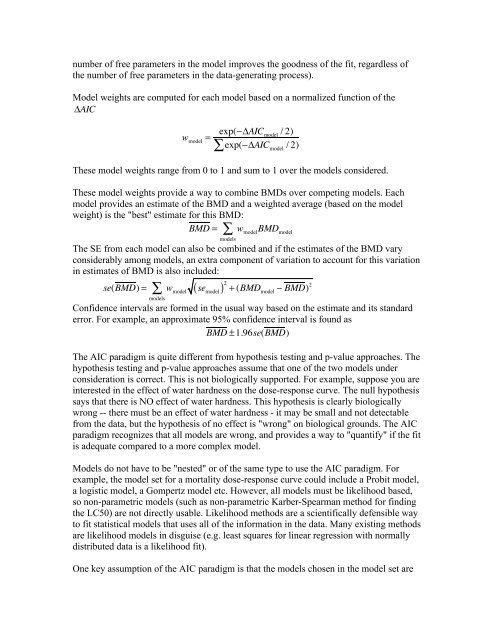Summary - People.stat.sfu.ca - Simon Fraser University
Summary - People.stat.sfu.ca - Simon Fraser University
Summary - People.stat.sfu.ca - Simon Fraser University
You also want an ePaper? Increase the reach of your titles
YUMPU automatically turns print PDFs into web optimized ePapers that Google loves.
number of free parameters in the model improves the goodness of the fit, regardless ofthe number of free parameters in the data-generating process).Model weights are computed for each model based on a normalized function of the!AICw model= exp(!"AIC model/ 2)#exp(!"AIC model/ 2)These model weights range from 0 to 1 and sum to 1 over the models considered.These model weights provide a way to combine BMDs over competing models. Eachmodel provides an estimate of the BMD and a weighted average (based on the modelweight) is the "best" estimate for this BMD:BMD = w modelBMD model!modelsThe SE from each model <strong>ca</strong>n also be combined and if the estimates of the BMD varyconsiderably among models, an extra component of variation to account for this variationin estimates of BMD is also included:"se(BMD) = w modelse modelmodels( ) 2 + (BMD model! BMD) 2Confidence intervals are formed in the usual way based on the estimate and its standarderror. For example, an approximate 95% confidence interval is found asBMD ±1.96se(BMD)The AIC paradigm is quite different from hypothesis testing and p-value approaches. Thehypothesis testing and p-value approaches assume that one of the two models underconsideration is correct. This is not biologi<strong>ca</strong>lly supported. For example, suppose you areinterested in the effect of water hardness on the dose-response curve. The null hypothesissays that there is NO effect of water hardness. This hypothesis is clearly biologi<strong>ca</strong>llywrong -- there must be an effect of water hardness - it may be small and not detectablefrom the data, but the hypothesis of no effect is "wrong" on biologi<strong>ca</strong>l grounds. The AICparadigm recognizes that all models are wrong, and provides a way to "quantify" if the fitis adequate compared to a more complex model.Models do not have to be "nested" or of the same type to use the AIC paradigm. Forexample, the model set for a mortality dose-response curve could include a Probit model,a logistic model, a Gompertz model etc. However, all models must be likelihood based,so non-parametric models (such as non-parametric Karber-Spearman method for findingthe LC50) are not directly usable. Likelihood methods are a scientifi<strong>ca</strong>lly defensible wayto fit <strong>stat</strong>isti<strong>ca</strong>l models that uses all of the information in the data. Many existing methodsare likelihood models in disguise (e.g. least squares for linear regression with normallydistributed data is a likelihood fit).One key assumption of the AIC paradigm is that the models chosen in the model set are
















